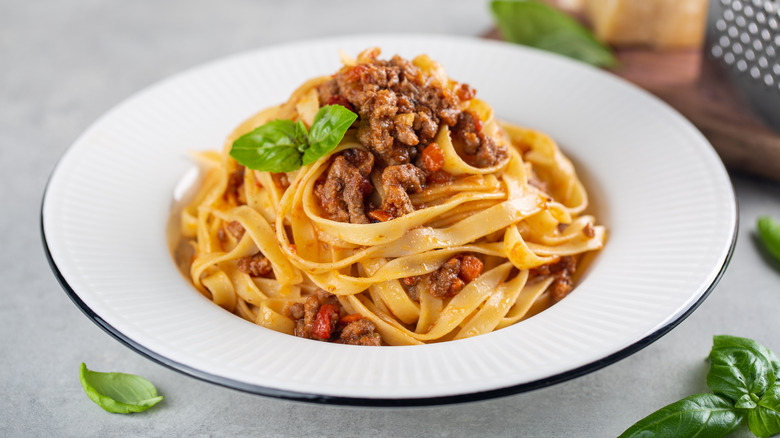What Is The Difference Between Ragù And Bolognese?
If you frequent Italian restaurants, you've likely tried ragù alla Bolognese. The tomato-based pasta is beloved in both Italian and Italian-American cuisine. It's a palatable and versatile dish, typically featuring pappardelle or tagliatelle. Because many Bolognese recipes also call for the use of milk, the sauce achieves a creamy consistency that perfectly balances with the texture of chopped meat.
Bolognese's popularity is not only a product of the sauce's taste but also of its history. According to Cucina Venti, Bolognese gets its name from Northern Italy's city of Bologna, though it's debated whether the dish actually originated from its namesake. Regardless of its source, ragù alla Bolognese — also known as Bolognese ragù — begins with a sofrito: a carrot, celery, and onion mixture. Once the vegetables are cooked, the beef can be incorporated, followed by the liquids.
Yet while ragù alla Bolognese clearly places ragù and Bolognese in tandem, the two are neither synonymous nor interchangeable. In actuality, ragù refers to a broader category of Italian sauces, whereas Bolognese represents just one version of how a ragù can take shape and taste.
Bolognese is a type of ragù and a variation of sauce
The difference between ragù and Bolognese is in the name. The English translation of the Italian "ragù alla Bolognese" literally means Bolognese sauce, placing Bolognese under the ragù umbrella. Per the Alpine Bakery and Trattoria, ragù is essentially a meat-based sauce with traces of tomato, whereas Bolognese branches off that sauce starting point.
The recipes for ragù and Bolognese are fairly similar, though ragù leaves more room for creativity. Ragù options range from the addition of monkfish to mortadella, though you typically begin with a sofrito, as well as tomatoes and meat. You'll also need to exercise patience and give your sauce plenty of time to cook (per La Cucina Italiana).
As such, ragù can refer to any number of loosely-defined meat-based sauces that have been cooked long enough for the flavors to meld. A sauce can take many forms and directions, so the next time you're making pasta, consider branching out from Bolognese. Or don't bother switching it up; Bolognese is always a hearty, fail-safe sauce.

